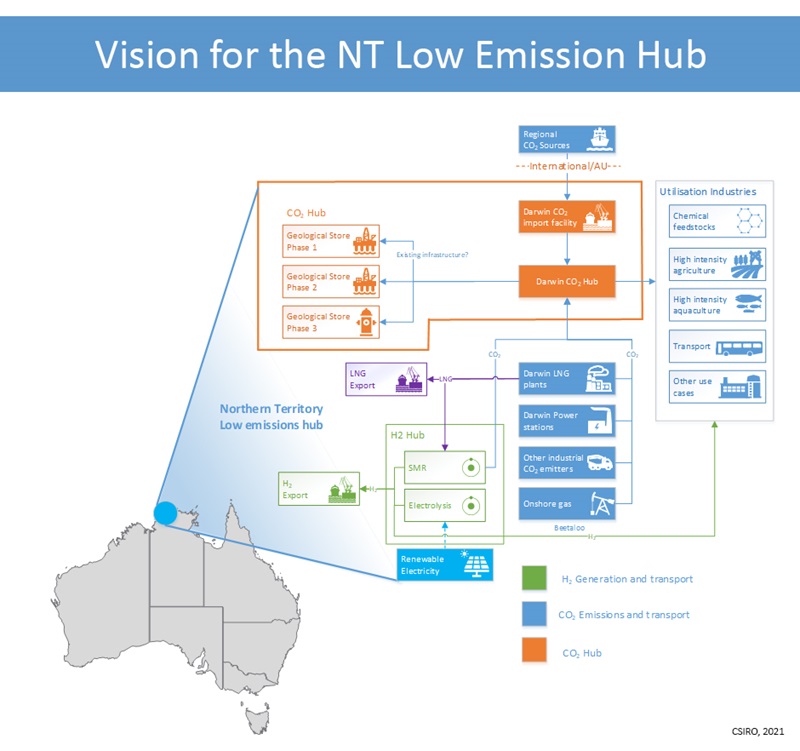The challenge
A decarbonisation blueprint
The plentiful resources of northern Australia make the region an energy export and a regional decarbonisation powerhouse. The Northern Territory has abundant natural gas and solar resources, significant carbon dioxide (CO2) storage capacity, and proximity to international markets. At the same time, the NT Government — which has officially adopted a 2050 net-zero emissions target — is looking to identify ways to rapidly decarbonise existing energy supplies whilst attracting future zero-emission industries.
Our response
A new collaboration to assess future opportunities in the Top End
CSIRO is leading a collaboration that will develop a business case to assess the viability of a large-scale Low-Emission Carbon Capture Utilisation and Storage (CCUS) Hub, based on Darwin's Middle Arm peninsula in the Northern Territory. We have partnered with the NT Government, and brought together an initial group of key industry and engineering companies, including INPEX, Santos, Woodside, Eni, Origin Energy and Xodus.
The aim of the Hub will be to reduce existing emissions significantly, by acting as a catalyst to new net-zero industries to continue beyond the energy transition. It will also enable the development of an interconnected hydrogen industry, and the use of captured carbon in other industrial processes, such as the production of non-fossil-fuel alternatives for transportation.
If realised, the Northern Territory Low Emission CCUS Hub will be one of the largest multi-user, multi-access hubs globally. It will involve close collaboration between the Northern Territory and Australian governments, a diverse range of industry research agencies like CSIRO, engineering and technology companies, and foreign governments.
Why the Northern Territory? Darwin is a gateway to South-East Asia and the location of globally significant liquid natural gas (LNG) export and industrial activity. One of the aims of the business case is to identify a transition pathway for industry in the region by sharing knowledge and experience that will help improve the likelihood of success.
The Hub could also be key to the establishment of the NT Government's Middle Arm Sustainable Development Precinct, which is being developed into a globally competitive location for low-emission petrochemical, renewable hydrogen, and minerals processing.
By taking a collaborative and regional view, an accelerated and sustainable industry transition can be explored.
Opportunities for CO2 utilisation in the Northern Territory Report
The NTLEH is exploring opportunities for CO2 utilisation in the NT as part of the integrated low emission industrial ecosystem. The 2023 Opportunities for CO2 Utilisation in the Northern Territory report explores five opportunities for CO2 utilisation including, methanol, jet fuel, methane, urea and mineral carbonates.
This report builds on CSIRO’s 2021 CO2 Utilisation Roadmap and explores opportunities for integrating CO2 utilisation applications into a low emission industrial hub in the Northern Territory.
Download the report
- Opportunities for CO2 utilisation in the Northern Territory PDF (4 MB)
- Opportunities for CO2 utilisation in the Northern Territory (accessible text) TXT (247 KB)
Our role
CSIRO is uniquely placed to drive the technology and collaboration necessary to develop a business case for the NT Low Emissions CCUS Hub. We have close partnerships with industry and the NT and Australian governments, and we have expertise across key industry sectors, including carbon capture utilisation and storage and hydrogen. For instance, we recently released the CO2 Utilisation Roadmap and we are leading Australia’s research in the clean hydrogen industry.
We have invested to accelerate the development of a robust business case for government and industry investment. We will do this by providing impartial scientific advice, coordinating the development of detailed concept designs, building international linkages, and conducting geological research and economic and customer studies.
The business case will apply best practice learnings from international low-emission industrial hub projects. It will also consider all technology solutions and engage with industry and community stakeholder groups as we navigate the transition pathway to a low-emissions future.
See the CSIRO and partners scope NT Hub to lower emissions and boost investment media release for quotes from the different partners.
The infographic for the NT Low Emissions Hub shows the different components of a potential hub that are separated into three main areas: Hydrogen (H2) generation and transport; CO2 Emissions and transport and the CO2 Hub.
This includes: 
